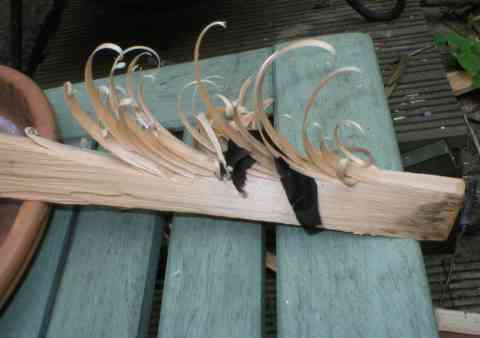This months review is of the Extrema Ratio Scout 1.
I had always wanted an Extrema Ratio knife but most of their products are on the expensive side, are clearly designed for tactical applications or were too large for what I was looking for in a bushcraft knife. When the Scout came out in 2017 though I saw something a little more affordable, the right size for bushcraft tasks and it was marketed by some sellers as a knife suitable for bushcraft;
"The Extrema Ratio Scout 1 knife is their version of a bushcraft, camp, scouting knife but what separates it from all others is the exceptional build quality and pure, functional design." Heinnie Haynes
If you look at Extrema Ratios website though they describe the knife as a 'back up knife' and don't mention bushcraft at all.
So what is a backup knife?
In the everyday sense it might just mean a knife that you have 'just in case' for opening boxes, cutting tape or string but really that's an edc knife. From a tactical point of view a backup knife might be carried in addition to a concealed firearm for situations when it's impossible to reach a primary weapon perhaps because a fight has become so close quarters that the firearm can't be bought to bear or because it's been lost or has malfunctioned. They might just be used to wound or scare an aggressor into backing off far enough to allow you to draw a gun or retreat yourself.
It is described as a backup knife but Extrema Ratio also produce a more aggressive version of the scout called the Defender with a pronounced guard and deep blood groove.
So whatever it's design rationale and intended function my intended use for the scout was as a bushcraft knife. I got one back in early 2017 so mine has been used over the last two years and I'm confident in the opinion that I have formed of it. It honestly hasn't seen much use in that time compared to a lot of my other knives and that is telling; there are reasons that it hasn't been used all that much.
Probably because it was never designed to be in the hand for all that long the handle is not comfortable for extended use. The distinctive Extrema Ratio handle with the rectangular indent might be the product of work between Extrema Ratio and the Motor Sciences Department of the University of Perugia in Italy and the result is a knife handle design perfectly suited to the human anatomy. It’s a much skinnier handle than most survival knives but sits in the hand beautifully, however bushcraft knives were never designed to sit in the hand and when you start to work hard with this knife it does become quite uncomfortable. Because it is so skinny it starts to twist in the hand during extended use and cause hot spots on the pinky and ring finger and palm of the hand.
 |
| The blade is perfect for feather stick making and other buschraft tasks but if you've got to make more than two or three you will start to feel the discomfort. |
The handle is made from foreprene, a material common to most of Extrema Ratio's knives and is extremely hard wearing, the handle does also feature a small divot, I think it's really a divot to allow you to easily find the handle and grip it securely in the dark or under stressful conditions but it could also be pressed to use as a divot for a bow drill. I'm not really a fan of using a knife as the bearing block for a bow drill as the risk of using an unsheathed knife very close to your leg while you work your bow seems unnecessary to me. Additionally the heat of the friction between the drill and handle seems to have damaged my handle a bit and the divot is quite shallow and flat which causes the upper point of the drill to flatten quite quickly causing unnecessary friction.
Unfortunately the handle lets down the other great features of the knife, the blade shape is reminiscent of Horace Kepharts knife and is perfect for woodcrafting and basic backwoods tasks. I did replace the sheath on mine though for a more 'rustic' option; while the MOLLE compatible sheath which can be reversed for left or right hand carry and which retains the knife with a retaining strap closed with two buttons would be great for tactical use attached to a plate carrier or webbing the belt loop is quite low down on the sheath so the handle protrudes quite a long way above the belt line and due to the angular exposed tang is very uncomfortable to carry. I replaced the sheath with a sharpshooter leather pouch sheath.

The scout is available with a black blade but the version I have has a stonewashed blade made from N690 stainless steel, the N690 steel is a great choice but can be had in other knives for significantly cheaper. The full length narrow tang is very strong and would be great to use in cold weather as it leaves no tang exposed and in constant contact with the hand. The texture on the first inch or so of the spine is not uncomfortable and does provide some extra grip but the swedge and 'false edge' along the spine from where the texture ends to the tip does make supporting cuts for whittling and wood craft very uncomfortable and leaves no sharp edge for striking a fire steel with.
An excellent feature of the scout is the fact that with the removal of a single bolt the whole handle can be slipped off for cleaning or perhaps with a bit of ingenuity the fitting of a replacement handle which would be more comfortable.
 |
| Extrema Ratio Scout with handle removed. |
So while certain features of the scout make it a great choice for bushcrafting others unfortunately let it down badly and I can't really recommend it in the form that is comes from the factory. A few modifications would make it a very strong contender for bushcrafting but as it is there are much better choices.
TODAY'S LESSON
I promised a lesson attached to every review; today's is a lesson on how I go about reviewing knives. To make sure I don't just ramble about a knifes performance I have specific criteria that I judge every knife on so that the reviews are consistent and relevant. All the reviews I do are based on basic bushcraft criteria although I don't limit the testing to 'bushcraft knives' at the end of the day whether a manufacturer chooses to use the word 'bushcraft' to market a knife or not doesn't make it more of a bushcraft knife than any other so some of the knives I test might be combat knives or hunting knives but the idea of a dedicated bushcraft knife is relatively new and knives obviously are not.To show you what I do to test each knife that features in the monthly reviews here on the blog I've included to hand written notes I made about the Extrema Ratio Scout 1 as I used it over the last two years or so.
I will include these notes for each knife in future reviews.
















































